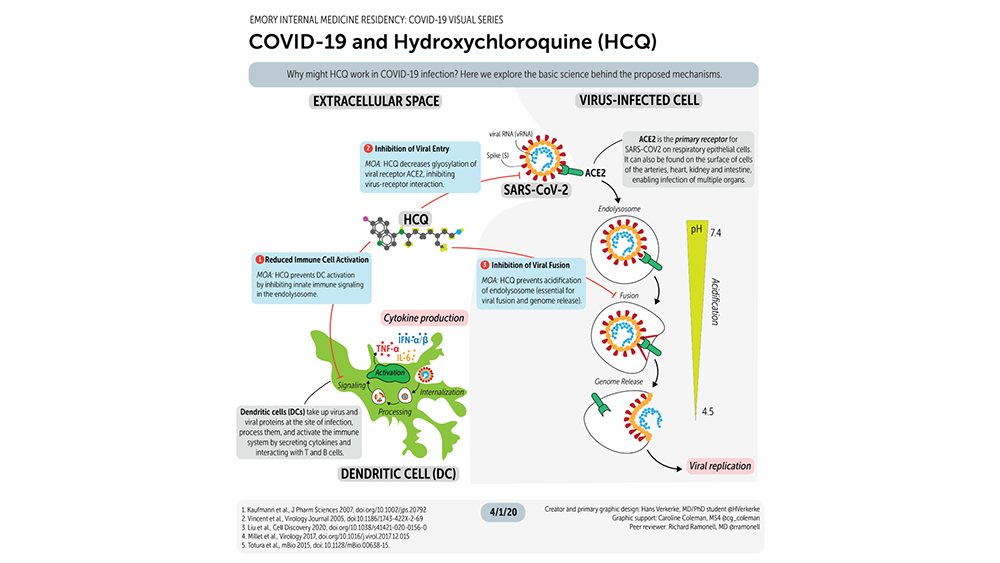Visualising pandemic studies: visual abstracts by medical students and fellows
Keeping up with the deluge of literature surrounding the COVID-19 pandemic presented a difficult challenge for healthcare workers, public health officials, scientists, policymakers and the general public. Finding an efficient yet accurate way to quickly review new literature and incorporate it into everyday practice seemed to be an unaddressed need.
COVID-19 VISUAL SERIES
In response to this need, our team created the Emory University COVID-19 Visual Series, a partnership between Emory medical students and infectious diseases (ID) fellows to summarise and disseminate COVID-19 research through visual abstracts. A visual abstract is a succinct visual summary of the key findings of an article. Medical students, who had been displaced from clinical duties due to the pandemic and had additional time to dedicate to the project, developed visual abstracts, which ID fellows or faculty reviewed for accuracy. Visual abstracts were then published online and on social media. Our team partnered with Cochrane to visually summarise their COVID-19 reviews. Participants earned Cochrane Membership points for their contributions and were also acknowledged on each visual created and tagged on social media to receive full credit for their work.

The Emory University COVID-19 Visual Series has grown into a sizeable collaboration between more than 100 students, residents, ID fellows and faculty. This initiative not only helped health professionals and the general public stay informed of recent, practice-changing COVID-19 literature, but also demonstrated a model for how scientific information can be efficiently disseminated to multiple audiences. Moreover, engagement in this initiative allowed students to hone their science communication skills and see the power of social media in disseminating information.
MAKING AN IMPACT
To date, this initiative has covered more than 120 high-impact manuscripts and over a dozen of Cochrane’s COVID-19-related reviews. Moreover, our visual abstracts have been shared widely, both on Cochrane’s and Emory’s websites and social media platforms, as well as 140+ collaborator groups, which includes Cochrane’s Facebook (>17,000 followers), LinkedIn (>20,000) and Instagram (>14,000) accounts, as well as Twitter accounts such as @CochraneCollab (>114,000), @TheCochraneLibrary (>76,500), @Wiley_Nursing (>12,000), @WileyHealth (>10,000), @EmoryMedicine (>10,000) and many more, with single tweets garnering up to >108,000 unique impressions and averaging >33,500 unique impressions. Abstracts have also been translated and disseminated in Spanish, Chinese and Japanese, further increasing the reach of our initiative.
THE VALUE OF A MULTI-LEVEL MODEL
Our initiative used an innovative multilevel trainee co-production model for the creation of communication products, and we demonstrated the educational and developmental value of engaging in this model. Our initiative recently conducted a survey of medical students to understand the benefits they received through participation and interaction with the greater scientific community. We found that through involvement with this initiative, medical students:
- learnt evidence-based medicine skills;
- refined scientific communication abilities;
- felt they contributed meaningfully to the medical community.
Our student-fellow visual abstract collaboration demonstrates that learners can contribute to and benefit greatly from the development of educational products. Student involvement in our project not only improved the quality of the visual abstracts, but also allowed students to build knowledge and skills, strengthen their professional identity, and pursue additional professional opportunities.
FACTORS FOR SUCCESS
In emergencies, the need for rapid, reliable dissemination of information is critical. Our COVID-19 Visual Series was a success because:
- visual abstracts are accessible, efficient and low-cost;
- medical students have the technical skill set to interpret the evidence and are motivated to contribute;
- expert mentorship and organisational partnerships ensure checks of evidence and pathways for enhanced dissemination efforts.
Our COVID-19 Visual Abstracts initiative can be used as a blueprint for achieving rapid, accurate and efficient science communication in times of future emergencies. They can also be used as a model for making science communication more accessible and economical. As a grassroots movement of medical students, we partnered with a global leader in systematic reviews to make healthcare evidence more accessible via our visual abstracts. We recommend that others interested in engaging in scientific communication in this way identify their target audience early and use their creativity, professional network and individual skills to provide easy-to-understand products to as many consumers as possible.
Links to additional resources
Examples of Cochrane COVID-19 explained in visual abstract form and learn about the students who participated
Emory University School of Medicine infographics and visual abstracts
Research conducted on the initiative:
https://onlinelibrary.wiley.com/doi/10.1111/medu.14249
https://academic.oup.com/ofid/article/7/Supplement_1/S586/6057866
Authors
Angel X Xiao
Caroline S Jansen
Yooree Grace Chung
Timothy Daugherty
Jennifer O Spicer
Caroline G Coleman
Affiliation: Emory University School of Medicine
Disclaimer
The views expressed in this this World EBHC Day Blog, as well as any errors or omissions, are the sole responsibility of the author and do not represent the views of the World EBHC Day Steering Committee, Official Partners or Sponsors; nor does it imply endorsement by the aforementioned parties.
